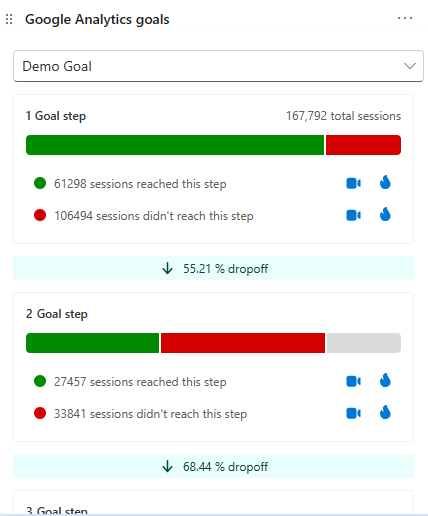What Data Is Google Analytics Goals Unable to Track: Essential Information
Wiki Article
Unveiling the Blind Spots: Comprehending What Google Analytics Goals Can not Determine
In the realm of digital analytics, Google Analytics stands as a powerful tool for tracking and evaluating online user interactions. Nevertheless, amidst its durable abilities, there exist blind spots that frequently avert dimension. Comprehending what Google Analytics goals can not determine is essential for acquiring a comprehensive sight of individual habits and engagement. As we explore the ins and outs of these dead spots, we uncover a complex internet of uncharted territories that hold beneficial understandings into user activities and motivations, challenging standard wisdom and shedding light on the constraints of our data-driven understanding.Individual Actions on External Platforms
Understanding exactly how users engage on external systems is essential for maximizing online approaches. External systems, such as social networks networks, referral web sites, and online discussion forums, play a significant function in driving website traffic to a business's internet site. By evaluating customer behavior on these systems, companies can gain useful understandings into the performance of their marketing efforts and the choices of their target audience.One trick aspect of customer habits on exterior systems is the reference resource. By tracking where the users are originating from, businesses can determine which systems are driving the most traffic to their site. This details can help business assign their sources better, concentrating on the systems that produce the most effective outcomes.

Offline Conversions and Interactions
Examining user actions on exterior platforms gives useful insights right into online approaches; nevertheless, considering offline conversions and communications is similarly important for a comprehensive understanding of a business's overall performance. Offline conversions, such as in-store purchases or phone questions, play a considerable role in many companies' success.
Attribution Beyond Last Click
When delving right into the world of electronic marketing analytics, it ends up being important to look beyond the single touchpoint of the last click for a more detailed understanding of acknowledgment. While Google Analytics gives valuable insights into user habits, depending exclusively on last-click acknowledgment can be limiting - what data is google analytics goals unable to track. Acknowledgment versions that exceed the last click supply a more nuanced view of the customer journey, taking into consideration all the touchpoints that result in a conversionAcknowledgment past the last click permits online marketers to designate credit to numerous interactions along the conversion course, giving a more clear photo of the effectiveness of different advertising and marketing networks. By exploring multi-touch attribution versions such as linear, time degeneration, or position-based acknowledgment, services can much better allot their marketing budgets and enhance their techniques for maximum impact.
Understanding the influence of each touchpoint in the conversion procedure is vital for making educated decisions and optimizing ROI. By accepting attribution past the last click, companies can gain much deeper insights right into client habits and customize their advertising and marketing initiatives much more effectively.
Cross-Device and Cross-Browser Tracking

Likewise, cross-browser monitoring enhances cross-device Check Out Your URL tracking by a fantastic read catching individual habits as they switch over in between different web internet browsers. Recognizing how users communicate with web sites on numerous browsers can help marketing professionals maximize their on-line experiences to guarantee uniformity and capability throughout different platforms.
Qualitative Information and Customer Intent
Recognizing user intent through qualitative data analysis is important for establishing targeted electronic marketing strategies that resonate with the requirements and choices of the target market. Qualitative information supplies insights into the 'why' behind user actions, dropping light on motivations, emotions, and preferences that quantitative data alone can not catch. By examining individual comments, comments, and interactions, marketers can uncover valuable details concerning individual intent, enabling them to customize their messaging, material, and offerings to much better line up with what their target market is seeking.Qualitative data likewise assists in recognizing the context in which users engage with a website or app. This contextual understanding allows marketing professionals to develop even more appropriate and customized experiences, ultimately driving higher involvement and conversion rates. By diving into user intent with qualitative data evaluation, businesses can obtain a deeper understanding of their target market, causing more reliable marketing approaches that meet customers' needs and assumptions.
Conclusion
Finally, Google Analytics objectives have restrictions in gauging user actions on external platforms, offline conversions, acknowledgment beyond last click, cross-browser and cross-device tracking, and qualitative data associated with individual intent. what data is google analytics goals unable to track. It is essential for companies to be knowledgeable about these blind spots in order to supplement their data evaluation with various other tools and techniques to obtain a more detailed understanding of their target market and improve their general electronic advertising and marketing techniquesBy assessing user habits on these systems, companies can get valuable insights right into the performance of their marketing efforts and the recommended you read preferences of their target audience.
Assessing customer behavior on outside systems gives useful understandings into on the internet methods; nonetheless, thinking about offline conversions and communications is equally critical for a comprehensive understanding of a company's general performance.In electronic marketing analytics, moving beyond last-click attribution to check out cross-device and cross-browser tracking is vital for obtaining an all natural understanding of customer communications throughout numerous systems and tools. By assessing user feedback, comments, and communications, marketers can uncover valuable information about user intent, allowing them to customize their messaging, web content, and offerings to much better straighten with what their audience is seeking.
By delving into customer intent with qualitative information evaluation, companies can get a much deeper understanding of their target audience, leading to much more reliable advertising and marketing methods that satisfy individuals' assumptions and requirements.
Report this wiki page